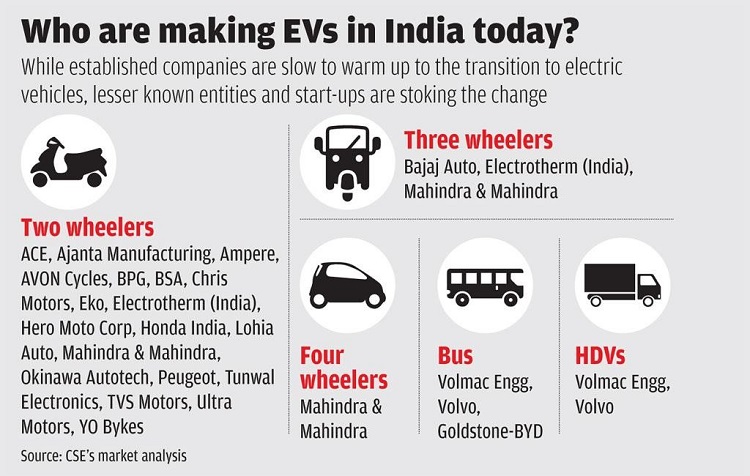2019 has been a pivotal year for the State Governments and Union Territories in India to come up with policies and initiatives for Electric Vehicles. The pivot comes at a time when India’s major cities saw high levels of pollution, some entering the top 10 most polluted cities in the world, including the national capital, Delhi. The shift to Electric Vehicles in India is taking place when China has taken a massive lead in a market that is still in its infancy and has already started to export Electric Vehicles in both commercial and private space.
Tamil Nadu, Punjab, Delhi, Chandigarh, Himachal Pradesh are some of the states and Union Territories of India which have come out with drafts of new Electric Vehicle Policies in 2019. NITI Aayog, the Union Government’s think tank, had come out with considerations for a policy framework regarding Zero-Emission Vehicles in September 20181 added with assurances through statements by NITI Aayog’s Chief Executive Officer and Vice-Chairman2 that a national policy is being formulated. Electric Vehicles' push in India is in line with the Electric Vehicles Initiatives (EVI) by the International Energy Agency started in 2010.

Source: https://www.autocarindia.com/car-news/ev-sales-in-india-cross-75-lakh-mark-in-fy2019-412542
U.S and China are co-leaders of the initiative mentioned above. China meanwhile, expects around 7 million EV annual sales by 2025.3 It is estimated in the U.S that 65 per cent of vehicles sold would be zero-emission vehicles contingent to lower operating costs, consumer acceptance and growth in charging stations. The European Environmental agency plans to halve fossil fuel-driven cars with additional plans to drive them out by 2050.4 The shift to electric vehicles in the U.S and Europe is gradual but slow. China has also taken a significant lead in taking control of Cobalt production sites and over global supplies and also to assert its dominance in the EV industry globally. It is already in control of 62 percent of the Cobalt production of the world. 5 Cobalt is used in batteries which are used in mobile phones and EVs. At least 10 percent of it has to be used in the cathode for safety and battery longevity.6
In 2019 though, China saw a 34 per cent drop by September 2019, according to the China Association of Automobile Manufacturers in the New Energy Vehicle market. The Chinese Government had doled out 3.1 Billion USD in subsidies in 2017, with a large share going to Yutong, the largest bus maker in China and BYD (Build Your Dreams) the top global electric car maker. Subsidies in 2019 were cut, leading to a dip in the new energy vehicle sales. Market experts believe that the Chinese government is pushing automakers into a desperate position where they would not be able to sell a well-built electric vehicle at a lower price. The cutting of subsidies puts smaller automobile companies focused on new energy vehicles at the cusp of bankruptcy as losses mount. Another reason for the slump is due to weak consumer sentiment backed by the ongoing trade conflict between the U.S and China. The trade conflict has led to less support for policy ranging from renewed subsidies for customers to loosening of restrictions on cars in major cities. 7
Meanwhile, in India, automakers are facing a dilemma, which might persist in 2020 as to whether they should focus on Electric Vehicles considering that there is no adequate infrastructure for the same. Automobile manufacturers like Bajaj Auto Ltd, TATA Motors, and Mahindra and Mahindra think that this dilemma needs to be put aside as it is the vehicle manufacturer’s responsibility to create the supply for EV which would then lead to the demand for the required infrastructure.8

(Source: https://www.downtoearth.org.in/coverage/energy/the-future-is-electric-59653)
The Chandigarh Electric Vehicle Policy after a close study indicates that there is more emphasis on laying down the groundwork for infrastructure which would help increase dependence on Electric Vehicles. Following that, the city aims to only aims to register Electric Vehicles after 2030.9 The Delhi government finally has released a draft EV policy that aims to counter increasing vehicular pollution in Delhi and plans to have 25 per cent of vehicles in Delhi to be Electric Vehicles by 2024 while also focusing on job creation in the financing, driving, servicing, selling and charging EVs. The Delhi Government also plans to subsidize purchasing charging equipment for commercial and personal use.10 The Himachal Pradesh Government through its policy, wants all vehicles in the state to transition to Electric Vehicles by 2030.11
The new Electric Vehicle policies in the states are in line with the National Electric Mobility Mission Plan of 2020 by the Ministry of Heavy Industries & Public Enterprises. The Mission has a target of 6-7 Million sales of Electric and Hybrid Vehicles in 2020. The Union Cabinet has approved an outlay of Rs.10, 000 crores which would be used over the next three years for offering upfront incentives on purchasing electric vehicles. Under this mission, Electric Vehicles will be kept under the lower bracket of 12 per cent of Goods and Services Tax (GST), exemptions of permits by the Ministry of Road Transport Highways for battery-operated vehicles and a host of other incentives.12
The year 2019 also saw the operational challenges in implementing EV policies, especially in Andhra Pradesh. The state government wanted to induct around thousand buses to replace the old fleet. The number was later reduced to 350 buses for 12 years by using incentives given by the National Electric Mobility Mission Plan. The problem is with the manufacturers, as there are only seven companies that manufacture battery operated commercial vehicles like a bus, but the demand is exceeding supply. Out of the 650 buses ordered by various states together, only half of them have been delivered. The cost of an Electric Buses was over Rs. 2 Crore. The state officials have estimated that around Rs. 200 crores have to be spent to develop adequate infrastructure for Electric Vehicles which is seen as a burden on the already precarious financial situation of the state.13
To conclude, 2020 brings new prospects, challenges, and questions for the Electric Vehicle sector in India.
The Prospects;
- The global automobile manufacturers see India as a potential market. Tesla, a leading U.S based Electric Vehicle manufacturer, has shown interest in setting up a battery plant in India.
- The National Electric Mobility Mission Plan would encourage other States and Union Territories to work on their respective Electric Vehicle Policies and take inspiration from their counterparts.
The Challenges;
- How much cost would India incur in importing cobalt, as China already has a monopoly in cobalt mining as cobalt prices are increasingly on the rise?
- Another challenge India faces is the lack of automobile manufacturers who are involved in battery-operated vehicle manufacturing.
- The awareness regarding the subsidies provided by Union, State and Union Territory governments is still lacking. The change from BSIV to BSVI has also led to massive drop in the sales affecting the automobile sector which is one of the stable sectors of the Indian economy.
The Questions;
- Whether global auto manufacturers would be willing to get their Zero-Emission Vehicles for sale in India considering, India’s EV policy is not adequately formulated?
- Would the state transport corporations be able to afford the electric buses, and not back out of commercial EV inductions following Andhra Pradesh’s example?
- How will electricity be generated to support the EV infrastructure? Is there going to be dependence on non-renewable sources of energy, which continues to be the mainstay of India’s energy backbone?
- Would the automobile manufacturers invest in battery-operated vehicles or also consider launching hybrid fuel-driven cars in the future to expand the consumers choice but at the same time risk losses?
- Would the Indian government now take initiatives to import cobalt and encourage State run battery manufacturing centres and invest in Research and Development for the same?
References
- NITI Aayog & World Energy Council.Zero Emission Vehicles (ZEVs):Towards a Policy Framework, 2018 https://niti.gov.in/writereaddata/files/document_publication/EV_report.pdf
- “India Has Game Plan for Electric Vehicles: NITI Aayog CEO.” The Economic Times. Economic Times, July 27, 2019. https://economictimes.indiatimes.com/news/economy/policy/india-has-game-plan-for-electric-vehicles-niti-aayog-ceo/articleshow/70410461.cms?from=mdr.
- Kearns, Jeff, Hannah Dormido, and Alyssa McDonald. “China’s War on Pollution Will Change the World.” Bloomberg, March 9, 2018. https://www.bloomberg.com/graphics/2018-china-pollution/.
- Electric Vehicles in Europe, a report by European Environmental Agency https://www.eea.europa.eu/publications/electric-vehicles-in-europe/download
- “Apple Aims to Lock up Cobalt Supply Deals for IPhone, IPad Batteries.” South China Morning Post, February 21, 2018. http://www.scmp.com/tech/enterprises/article/2134130/apple-talks-buy-key-mineral-used-batteries-china-secures-bulk.
- Perks, Cameron. “The Role of Cobalt in Battery Supply.” Industrial Minerals, September 16, 2016. http://www.indmin.com/Article/3586106/The-role-of-Cobalt-in-battery-supply.html.
- Shepherd, Christian. “China New Energy Vehicle Sales Drop 34%.” Financial Times, October 14, 2019. https://www.ft.com/content/adeb6c18-ee53-11e9-bfa4-b25f11f42901.
- Panday, Amit. “Electric Vehicle Demand Creation Is Job of Vehicle Manufacturers: Rajiv Bajaj.” Livemint, November 24, 2019. https://www.livemint.com/auto-news/electric-vehicle-demand-creation-is-job-of-vehicle-manufacturers-rajiv-bajaj-11574558585315.html.
- Rohtaki, Hina. “Chandigarh Draft Policy Pushes for Electric Vehicles, Lists Subsidy, Free Parking.” The Indian Express, October 26, 2019. https://indianexpress.com/article/cities/chandigarh/chandigarh-draft-policy-pushes-for-electric-vehicles-lists-subsidy-free-parking-6088667/.
- Khanna, Pretika, and Shreya Nandi. “Delhi Cabinet Approves Policy on Electric Vehicles to Curb Pollution.” Livemint, December 23, 2019. https://www.livemint.com/news/india/delhi-cabinet-approves-policy-on-electric-vehicle-to-curb-pollution-11577100836999.html.
- TNN. “HP Aims at 100% Transition to Electric Vehicles by 2030: Shimla News - Times of India.” The Times of India, September 19, 2019. https://timesofindia.indiatimes.com/city/shimla/up-100-team-save-newly-born-girl-from-drain-earn-applauds/articleshow/71195731.cms.
- “Implementation of National Electric Mobility Mission Plan,” July 8, 2019. https://pib.gov.in/newsite/PrintRelease.aspx?relid=191337.
- “Plan to Introduce Electric Buses in Andhra Pradesh Dropped.” The Hindu, November 19, 2019. https://www.thehindu.com/news/national/andhra-pradesh/plan-to-introduce-electric-buses-in-andhra-pradesh-dropped/article30018800.ece?fbclid=IwAR2uK3c4rxNlXnDHBc2LzcRjFOB-QPwT7z4HxjpQoUJ7DgijtQv999M4pkw
(The paper is the author’s individual scholastic articulation. The author certifies that the article/paper is original in content, unpublished and it has not been submitted for publication/web upload elsewhere, and that the facts and figures quoted are duly referenced, as needed, and are believed to be correct). (The paper does not necessarily represent the organisational stance... More >>
Image Source: https://www.bilkulonline.com/wp-content/uploads/2017/11/charging.jpg











Post new comment